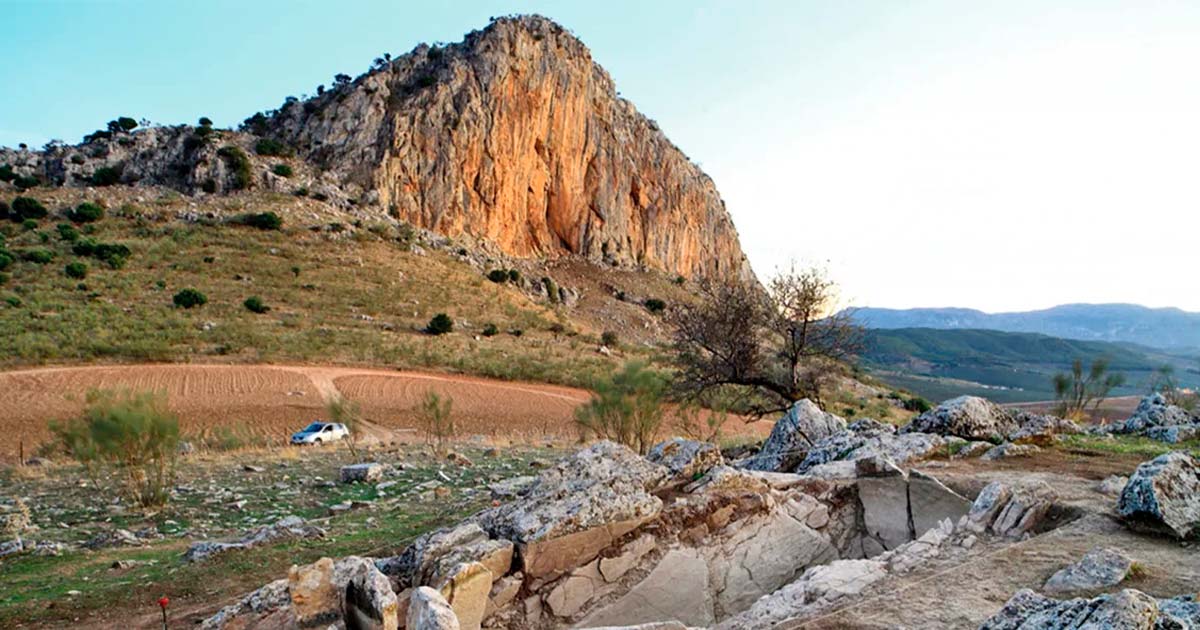5,000-Year-Old Astro-Tomb Discovered On Spanish Giant
As archaeologists in Spain were researching a rock formation known as the Sleeping Giant, they noticed something curious. From a distance, they identified a feature on the giant’s chest, which turned out to be a hidden and astronomically aligned tomb – now known as the Piedras Blancas tomb - dating back 5,000-years!
The Antequera archaeological site is located in the Andalusia region of Spain, about 458 kilometers (285 miles) southwest of Madrid, which comprises a series of ancient structures such as the Menga, Viera and El Romeral megaliths, dating back to the third and fourth millennia BC. All of these sites are located within eyeshot of two predominant geological formations known as El Torcal and La Peña de los Enamorados.
- Who Were the Ancient People that Built the Remarkable Megalithic Tombs of Malaga?
- They're Alive! Megalithic Sites Are More than Just Stone
A study published in the journal Antiquity presents new research on an overlooked megalithic site which was discovered on La Peña de los Enamorados, which means “Lover’s rock.” Towering about 883.92 meters (2,900 feet), the researchers said that this rock formation, which is described as “a stone sleeping giant,” was the keeper of a deeply-ancient secret - the Piedras Blancas tomb, meaning the “white stone” tomb.

General view of the excavated Piedras Blancas tomb or megalithic grave from the east, with numbering of the stones. At the far end, the two ‘arrow-like’ slabs attached to the bedrock. (M. Ángel Blanco de la Rubia and L. García Sanjuán / Antiquity Publications Ltd)
Probing A Sleeping Giant’s Chest at Piedras Blancas Tomb
Lead author of the new paper, Leonardo García Sanjuán, a Professor in Prehistory at the University of Seville (Spain), said the location of the Piedras Blancas tomb was “carefully chosen.” When observed from a distance, with La Peña de los Enamorados in the background, the tomb was situated on “the chest of the sleeping giant,” according to Prof. Sanjuán.
This rectangular stone-built tomb was constructed at the same time as the oldest megaliths in Antequera, which date back to 3,000 BC. At this time ceramic offerings were left in the tomb, and the researchers suspect that corpses were laid out on a large flat stone platform. Later, the decaying bodies were pushed off the stone platform into an area behind, where the researchers unearthed “40 teeth and 95 bones.”
High Status Living and Dying at Piedras Blancas Tomb
Around 2,500 BC, the Piedras Blancas tomb was enhanced and a pair of stone burial niches were installed. The researchers think that these two burial spots were constructed to accommodate a “high-status” male and female couple.
The paper also explained that sometime later the Piedras Blancas tomb “underwent another significant transformation,” when new blocks were added. The researchers said that these stones seemed to “block or seal” the entrance to the tomb.
Moreover, around the time of the renovations the bones of “at least two children and three women” were interred in the tomb. The study concluded that the Piedras Blancas tomb was used in three distinct phases, before being abandoned between 1950 and 1180 BC.

A skeleton buried in the added burial niches at the Piedras Blancas tomb. (M. Ángel Blanco de la Rubia / Antiquity Publications Ltd)
The Piedras Blancas Tomb Was Built On Solid Astronomical Foundations
On another level, the researchers noted a series of building orientations and geodetic alignments which have astronomical significance. The term “Megalithic astronomy” refers to the construction of large stone structures, such as stone circles and tombs, which were used to observe astronomical phenomena during the Neolithic period, around 3000 BC.
- How Ancient People Marked the Equinox Around the World
- Unbelievable Find of Europe’s Largest Megalithic Site in Spain
All over the world around 3,000 BC, stone structures were being carefully oriented and aligned with key celestial events, such as the solstices, cross-quarters days and equinoxes. Because such megalithic sites were designed for calendar keeping, for agricultural purposes, annual rituals and celebrations were conducted on key days, at these sites.
Solar Worship at Piedras Blancas Tomb 5,000 Years Ago
The study demonstrates how all of the floor slabs within the Piedras Blancas tomb were “carefully arranged” to align with the summer solstice sunrise on 21 June, marking the longest day of the year. This solar dynamic can also be found in the Neolithic observatory/tombs found at Newgrange in Ireland, Maeshowe in Orkney, and all across megalithic Europe.
Another example of megalithic astronomy is reflected in the positions of the heaviest engraved slabs. The researchers said the largest megaliths were “precisely placed to ‘funnel’ the light from the rising sun towards the back of the chamber at the summer solstice.” Furthermore, the archaeologists identified a “triangular, arrow-like stone” lodged into the floor, oriented in the direction of the rising sun.
Top image: The Piedras Blancas tomb with La Peña de los Enamorados behind it. Source: M. Ángel Blanco de la Rubia / Antiquity Publications Ltd
By Ashley Cowie

















